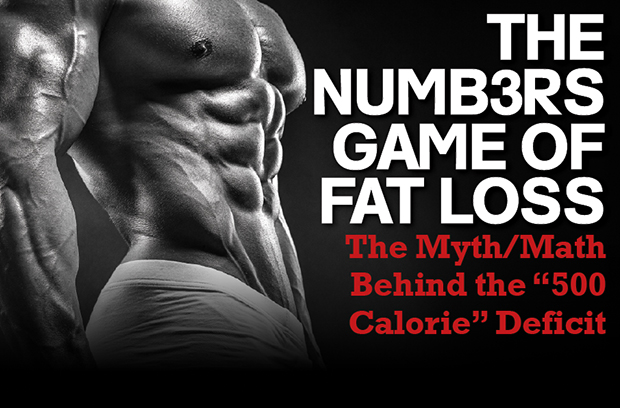Debunking The 500 Calorie Deficit Myth

There are basically three approaches to weight loss: You can reduce your caloric intake, you can increase your activity levels, or you can do a combination of both. Seems simple enough, but knowing how many calories to cut, or how much cardio to do can leave many people stumped.
The notion of 3,500 calories equaling a pound for weight loss is well-known and has guided many diet plans. It dates back to 1958, when Max Wishnofsky published his article “Caloric Equivalents of Gained or Lost Weight.” The goal of the paper was to answer the question “What caloric deficit is needed to achieve a loss of one pound of body weight?” He concluded that a reduction of 500 calories a day would yield the 3,500 calories necessary for a one-pound weight-loss effect to be seen at the end of the week (500 × 7 = 3,500).
This approach to weight loss has been popular for a long time because it’s simple to understand and apply. Also, when things are black and white, this is a seemingly logical approach. However, when it comes to the human body and how it functions, there’s a lot of grey area to consider.
The study of the human body and its functions has come a long way since 1958. So, before accepting or dismissing this long-trusted rule, it’s necessary to investigate the science of weight loss and understand more of how the body functions.
Eat Less, Move More
 The basic principle of dieting for weight loss is simple: Strike a negative calorie balance over the course of the day. This can be done by reducing what you eat and by increasing what you do. These two approaches encompass the calories you’re aware of, at least. However, other factors matter when considering the whole picture of weight loss, and they all add up to your total daily energy expenditure (TDEE). Although some may seem insignificant, when it comes to weight loss, every number counts!
The basic principle of dieting for weight loss is simple: Strike a negative calorie balance over the course of the day. This can be done by reducing what you eat and by increasing what you do. These two approaches encompass the calories you’re aware of, at least. However, other factors matter when considering the whole picture of weight loss, and they all add up to your total daily energy expenditure (TDEE). Although some may seem insignificant, when it comes to weight loss, every number counts!
Calories In, Calories Out
The human body is a fascinating machine capable of thousands of functions. The root of these functions—the body’s prime focus—is to keep you alive. To do this, it requires energy, which is obtained from the food you eat. The calories taken in are burned at varying rates, depending on one’s metabolism and level of activity. In addition to metabolism, various other functions burn energy throughout the day, some of which you may not be aware of.
Metabolism & Basal Metabolic Rate
 Starting at the most primal level, metabolism refers to the chemical transformations that happen in the cells of all living creatures. These transformations are responsible for the conversion of fuel to energy, fuel for the building blocks of proteins, fats, and carbs, as well as the elimination of waste from the body.
Starting at the most primal level, metabolism refers to the chemical transformations that happen in the cells of all living creatures. These transformations are responsible for the conversion of fuel to energy, fuel for the building blocks of proteins, fats, and carbs, as well as the elimination of waste from the body.
Metabolism is individual; each person will utilize calories at different levels and efficiency. You likely know a handful of people who claim to have “fast metabolisms” as they can eat whatever they want and not gain weight. Another feature of metabolism is that it’s dynamic and is affected by dieting and changes to body composition.
Basal metabolic rate (BMR) is the rate of energy your body burns when it’s at rest and isn’t actively digesting food. While this may not seem like much, it encompasses all the functions you perform involuntarily such as breathing, circulating blood, regulating body temperature, and brain function. These processes actually account for 60 to 75 percent of the calories burned on a daily basis—doesn’t seem so insignificant now, does it?
Various factors affect your BMR such as your body composition, age, and gender. Generally, individuals who weigh more or carry more muscle mass will burn more calories while at rest. However, as we age, our BMR slows down, which can also be correlated to the muscle lost due to aging. Finally, men generally have a higher BMR than women.
Exercise Activity Thermogenesis (EAT)
 Engaging in intentional exercise—whether it’s aerobic or anaerobic—is going to account for approximately 10 percent of calories burned over the course of a day. Various factors come into play with exercise-based calories, similar to BMR. Factors such as gender, body weight, and body composition will affect the caloric burn.
Engaging in intentional exercise—whether it’s aerobic or anaerobic—is going to account for approximately 10 percent of calories burned over the course of a day. Various factors come into play with exercise-based calories, similar to BMR. Factors such as gender, body weight, and body composition will affect the caloric burn.
Additionally, the type of exercise can greatly alter your numbers. For example, steady-state cardio will burn calories as the exercise is being executed, whereas HIIT cardio and weight training result in a prolonged state of expenditure lasting up to 24 hours. Another, more obvious, factor is the level of intensity; keeping your heart rate up throughout your session will be more beneficial for weight loss than taking long breaks between sets. Finally, don’t rely on the calorie counters on cardio equipment to guide your weight loss. The numbers generated are an average to give a general idea, but they can be off by 10 to 40 percent.
However, it’s important to be aware that exercise likely doesn’t burn the calories many people assume or expect it to. If a 160-pound person went for a 30-minute jog, he or she would burn an average of 300 calories, which can easily be erased with a blueberry muffin from your favourite coffee shop. So, eating those post-workout donuts because “you earned it” may be thwarting your weight-loss efforts. Remember, EAT is only accounting for 10 percent of your daily calorie burn! Generally, time spent exercising is only about 4 percent of your entire day, making your diet much more important in reaching a weight-loss goal.
Non-Exercise Activity Thermogenesis (NEAT)
While you may overlook actions such as walking around the grocery store, washing the dishes, or simply fidgeting at your desk, they all expend energy. These activities comprise NEAT and can account for 15 to 20 percent of your daily calorie burn. There’s a large range between individuals as some people are very sedentary, while others have difficulty sitting in one place for any length of time.
Diet-Induced Thermogenisis (DIT)
 You may have heard of the thermogenic effect of food, also known as diet-induced thermogenesis. Digesting food to use for fuel is a basic function your body needs to perform for survival, and is recently gaining more attention. Macronutrients have been found to cause different levels of thermogenesis in our bodies, with protein ranking the highest at 35 percent, followed by carbohydrates at 30 percent and fats at 10 percent. Overall, this factor accounts for 10 percent of calories burned over the course of a day.
You may have heard of the thermogenic effect of food, also known as diet-induced thermogenesis. Digesting food to use for fuel is a basic function your body needs to perform for survival, and is recently gaining more attention. Macronutrients have been found to cause different levels of thermogenesis in our bodies, with protein ranking the highest at 35 percent, followed by carbohydrates at 30 percent and fats at 10 percent. Overall, this factor accounts for 10 percent of calories burned over the course of a day.
If you’re looking to maximize DIT, you can try eating spicy foods as they cause a spike in calorie-burning activity. In fact, many over-the-counter fat-burning products contain some form of spicy food, most commonly capsicum, or chili peppers. Another dietary product found to boost your metabolic rate is green tea, due to the catechin epigallocatechin gallate (EGCG).
Total Daily Energy Expenditure (TDEE)
Your TDEE is the total number of calories burned throughout the day, combining all these factors together. In summary of calorie expenditure, your BMR accounts for 60 to 70 percent, EAT accounts for 10 percent, NEAT accounts for 15 to 20 percent, and DIT accounts for 10 percent, which adds up to your TDEE.
While it’s nearly impossible to know your exact numbers for these factors without access to a specialized human science lab, having a rough idea of them is helpful when weight loss is your goal. In some cases, just even being aware of these factors can be helpful enough as it may make individuals more conscious of their decisions throughout the day to strike a healthy caloric balance.
Doing the Math
 With all these facts, we can return to the original question: Is a reduction of 500 calories a day the solution to reach the desired effect of weight loss? Or is there a set formula to follow when losing weight? Well, if your goal is to lose just a couple of pounds, this could probably work. However, if your goal physique requires a larger weight loss, science says likely not.
With all these facts, we can return to the original question: Is a reduction of 500 calories a day the solution to reach the desired effect of weight loss? Or is there a set formula to follow when losing weight? Well, if your goal is to lose just a couple of pounds, this could probably work. However, if your goal physique requires a larger weight loss, science says likely not.
The predominant reason this logic fails is the body’s ability to quickly adapt to its environment. Recall that the primary goal of your body is basic survival, so it will adapt its level of function to adjust to a lower caloric intake. This allows it to maintain homeostasis, where it’s comfortable and can perform its day-to-day tasks. How does it adapt? It lowers its BMR, slowing down your metabolism to conserve energy.
With weight loss comes a loss of metabolically active tissue (hopefully fat). This in turn results in less mass to burn calories, along with a lowered BMR—two factors that will slow progress. Over time, and with further weight loss, this downregulation continues, which makes weight loss more difficult. What was working previously, such as your daily calorie cut, doesn’t spark change.
In many sports, fairly large weight-loss plans are needed. Athletes who need to make weight cut-offs or meet certain aesthetic standards often face months of dieting in preparation. Following a set formula, such as the 500-calorie-deficit-per-day rule, would quickly result in the athlete running out of food and doing excessive amounts of cardio, which is problematic for performance as well as aesthetics.
A reduction of 500 calories per day is dramatic and would be challenging to utilize for any length of time. If the average person is looking to lose 15 to 20 pounds, is currently consuming roughly 2200 calories per day, and is already doing some level of exercise, there isn’t a lot of room in their plan to remove 500 calories per day for very long. Rather, small, gradual changes made to input and output are more sustainable and leave room in the future to continue progress.
What’s Burning?
 Another aspect to consider, especially as athletes, is the ideal type of weight loss. While some of your composition is non-negotiable, such as your organs, bones, and connective tissues, your body will pull weight from both muscle and fat cells indiscriminately. As far as your body is concerned, it needs energy to survive and will draw it from anywhere necessary. Unfortunately, muscle is the easier energy source of the two.
Another aspect to consider, especially as athletes, is the ideal type of weight loss. While some of your composition is non-negotiable, such as your organs, bones, and connective tissues, your body will pull weight from both muscle and fat cells indiscriminately. As far as your body is concerned, it needs energy to survive and will draw it from anywhere necessary. Unfortunately, muscle is the easier energy source of the two.
To this point, when losing weight, you want to do your best to protect your muscle mass and drop primarily body fat. Finding your optimal balance of macronutrients, maintaining a high protein intake, and weight training to stimulate the muscle is beneficial. Going extremely low calorie and relying heavily on cardio for prolonged periods of time can lead to muscle loss, which will negatively affect your metabolic rate, compounding the issues against which your body is already fighting when dieting.
Eat More to Lose
 Although the notion of eating more seems counterintuitive to anyone trying to lose weight, it has proven to be helpful. All weight-loss journeys will result in plateaus at some point. If they occur deep into the diet and biofeedback indicates that metabolism is fighting the process, this strategy is beneficial.
Although the notion of eating more seems counterintuitive to anyone trying to lose weight, it has proven to be helpful. All weight-loss journeys will result in plateaus at some point. If they occur deep into the diet and biofeedback indicates that metabolism is fighting the process, this strategy is beneficial.
A solution relied on by physique athletes is refeeding. In these cases, the athlete will take in a calorie count slightly above their maintenance quantity for a day or two, and then return to his or her dieting intake. This influx of calories helps progress by stimulating the metabolic rate, giving it plenty of energy to burn and letting the body know that it has the energy to work with. When using this tactic, be aware that it may cause an increase in weight for a day or two following the spike in calories, but then should yield a loss.
This strategy clearly goes against the basic numbers game of weight loss, but bodybuilders have successfully used it for many years. The additional benefit to this approach is that the calories can work to restore hormone levels and provide a surge of energy for training sessions. Both factors will directly help promote positive progress.
At the base of weight loss, you must always consider the individual. Everyone will respond to nutrition and activity changes differently, making it impossible to predict weight-loss behaviours with a universal formula. Finally, keep in mind that progress is never linear. There will be plateaus and hard sticking points. Read into what your biofeedback is telling you and adjust the plan as needed, rather than simply grinding forward and continually cutting your food. In the case of weight loss, the grey area wins—there are no simple black-and-white solutions or formulas.
Tips for Healthy Weight-Loss
 Don’t crash diet! Large, rapid calorie decreases may yield sudden results, but they will be short lived and affect your metabolism in a negative way. This is why bodybuilders take four months to lose their weight; it allows for gradual alterations in calories and energy expenditure. This also serves to protect as much muscle mass as po ssible, which is a benefit to your metabolism.
Don’t crash diet! Large, rapid calorie decreases may yield sudden results, but they will be short lived and affect your metabolism in a negative way. This is why bodybuilders take four months to lose their weight; it allows for gradual alterations in calories and energy expenditure. This also serves to protect as much muscle mass as po ssible, which is a benefit to your metabolism.- Track your caloric intake regularly and monitor your results. Knowing what you’re consuming versus expending will let you know how you’re doing and what changes to make to keep progressing.
- Drink plenty of water and get enough sleep and recovery time. These factors help regulate many of the body’s systems and balance hormones.
- If it’s not broken, don’t fix it! If you’re experiencing weight loss, don’t cut macros or increase output. Let the body continue to progress at these levels before you go further into a negative balance.

